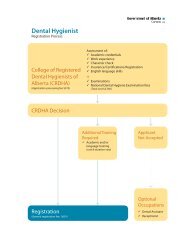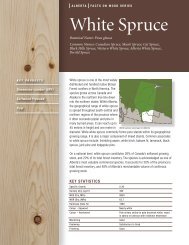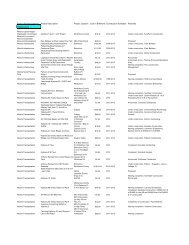Wide-open skies WJD:Layout 1.qxd - Alberta, Canada
Wide-open skies WJD:Layout 1.qxd - Alberta, Canada
Wide-open skies WJD:Layout 1.qxd - Alberta, Canada
You also want an ePaper? Increase the reach of your titles
YUMPU automatically turns print PDFs into web optimized ePapers that Google loves.
TRAINING<br />
<strong>Wide</strong>-<strong>open</strong> <strong>skies</strong><br />
RICHARD GARDNER reports from Western <strong>Canada</strong> on a new initiative that revives a great tradition of pilot training.<br />
During WW2 over 130,000 RAF,<br />
Commonwealth and Allied military<br />
aircrew learned their flying and<br />
navigation skills in the wide <strong>open</strong><br />
<strong>skies</strong> right across <strong>Canada</strong>. The British<br />
Commonwealth Air Training Programme<br />
operated from 1940 until 1944 and even<br />
today there are many visual reminders of<br />
these hectic flying days when more than<br />
10,000 of trainers, including hundreds of<br />
Tiger Moths and Ansons, filled the <strong>skies</strong> over<br />
sprawling air bases, six of which were located<br />
in <strong>Alberta</strong>. Now, though most of the largest<br />
bases are overgrown sites gently returning to<br />
nature, numerous gate guardian Harvard<br />
trainers remind passers-by of what were once<br />
part of the most extensive air training scheme<br />
in history. Their student pilots went on to fly<br />
everything from Lancasters over Germany<br />
and Liberators over Burma to Hurricanes<br />
O XX<br />
over North Africa and India. Many of these<br />
old airfields have survived and continue in<br />
use for regional transportation<br />
or as recreational<br />
flying and training airports.<br />
The reason why they were<br />
built in the first place has<br />
not changed — <strong>Canada</strong><br />
remains an excellent location<br />
for all aspects of flying<br />
training — and this has<br />
led to a new collective<br />
marketing initiative by a<br />
group of companies in<br />
<strong>Alberta</strong>, designed to offer a<br />
highly competitive training<br />
product for commercial<br />
would-be pilots, including training on fixedwing<br />
and rotary aircraft, on single or multiengine<br />
types.<br />
Their student pilots<br />
went on to fly everything<br />
from Lancasters<br />
over Germany and<br />
Liberators over Burma<br />
to Hurricanes over<br />
North Africa and India.<br />
“<br />
”<br />
Known as the <strong>Alberta</strong> Professional Pilot<br />
Trainers (APPT), this is a group of <strong>Alberta</strong> flight<br />
schools focused on<br />
commercial pilot training<br />
with operations based in<br />
Edmonton, Cooking Lake,<br />
Red Deer, and Wetaskiwin.<br />
The participating companies<br />
include E-Z Air<br />
Helicopter Services at<br />
Edmonton, the Cooking<br />
Lake Air Academy, Sky<br />
Wings Aviation Academy<br />
at Red Deer and<br />
Wetaskiwin Air Services.<br />
Offering quality training<br />
and a structured process to<br />
best exploit the groups many aircraft types and<br />
ground training facilities, including simulators,<br />
perhaps the biggest benefits to customers are<br />
May 2010 Aerospace International www.aerosociety.com
Left: General view of the general aviation<br />
area at Edmonton.<br />
uncongested airspace with (mostly) clear <strong>skies</strong><br />
and relatively low fuel and insurance costs. The<br />
APPT calls this ‘The <strong>Alberta</strong> Advantage.’<br />
An ability to meet pilot licence standards<br />
within minimal training times is due largely to<br />
the locations where the training is based, cutting<br />
out wasted time travelling to and from the<br />
airfields and waiting for the weather to improve.<br />
Many students can live right on the doorstep<br />
while on their courses and then make full use of<br />
the time available to get up into the air, carry out<br />
their tasks, and get down again. Extensive<br />
ground training aids are available to them, to<br />
help familiarisation with the cockpit layout and<br />
controls, and radio and airport procedures as<br />
well as handling emergencies. The simulators<br />
can replicate 19 different types. The training<br />
schools linked in the scheme are licenced by<br />
Transport <strong>Canada</strong> and are all members of the<br />
Air Transport Association of <strong>Canada</strong> and the<br />
Helicopter Association of <strong>Canada</strong> (HAC)<br />
At Cooking Lake Air Academy, Cessna 172s<br />
are available with glass cockpit technology and<br />
all aircraft are fitted with GPS navigation<br />
systems, which have brought much extra confidence<br />
operating over relatively remote areas and<br />
featureless prairie grasslands and forests. The<br />
transition from private pilot to a commercial<br />
pilot can be achieved quickly and compared to<br />
most other parts of the Western world, at considerably<br />
less cost. For example, C$67,000 will buy<br />
a package of air and ground training for a heli-<br />
copter licence, including 100 hours of flying.<br />
Helicopter training can be achieved in just six<br />
months on a full-time course, or one year for<br />
fixed wing. One of the APPT founders, and<br />
president of E-Z Air Helicopter Services, Ezra<br />
Bavly, told Aerospace International: “The<br />
Canadian licencing standards are very high and<br />
are known for this worldwide. We know what is<br />
being offered in the training market and we use<br />
best practice procedures all the time. We have a<br />
unique video recording record of a student’s<br />
progress so we can play-back for de-briefing after<br />
A Bell Jet-Ranger simulator training session at E-Z Air Helicopter Services.<br />
TRAINING<br />
Representatives of the <strong>Alberta</strong> Professional Pilot Trainers group in the E-Z Air Helicopter<br />
Services hangar.<br />
every session.” He added: “We have identified<br />
new niche training markets, such as medivac<br />
flying. Helicopter growth is big business, with<br />
more helipads on high-rise buildings and a<br />
consequent need to train for these operations.”<br />
Recently, a marketing team from APPT<br />
visited India where it attracted much interest.<br />
Again Ezra explained: “There are 325 airports in<br />
India but some have very limited facilities and<br />
there is a huge need for more pilots. We think<br />
there is scope for training new pilots here where<br />
the cost is affordable and where we have very<br />
experienced instructors.” Transferring commercial<br />
pilot licences is more difficult between some<br />
countries. APPT flying schools provide assistance<br />
in obtaining Canadian visas and other<br />
documentation and the group has discussed<br />
training opportunities with Indian DGCA and<br />
airline representatives. Apart from meeting<br />
certain academic requirements, the conversion<br />
of a Canadian CPL to India’s DGCA licence<br />
requires written examinations and a conversion<br />
of a Canadian Radio Licence to an Indian Radio<br />
Permit. This is a simple process, however,<br />
involving the correct answering of some 25<br />
questions. A local expert is available to provide<br />
assistance with preparing for the exams and<br />
seeing through the licence conversion.<br />
With a small but very well-educated and<br />
sophisticated population, and a world-class<br />
aviation legacy, <strong>Canada</strong> is a country ideally<br />
placed to develop its aeronautical services to<br />
supply a wider market. Flying training remains<br />
an aspect of aviation activity that will always be<br />
in demand where the conditions are favourable<br />
— and <strong>Alberta</strong> has that in spades.<br />
www.aerosociety.com May 2010 Aerospace International XX<br />
O<br />
O











